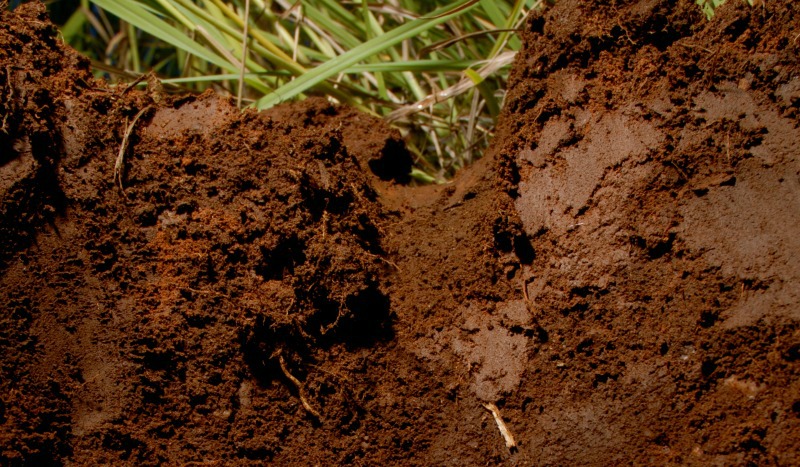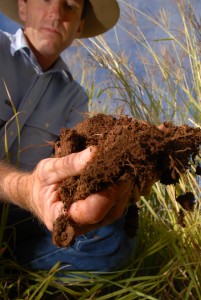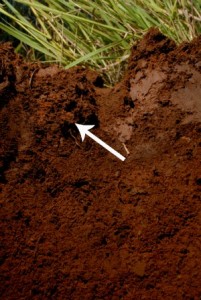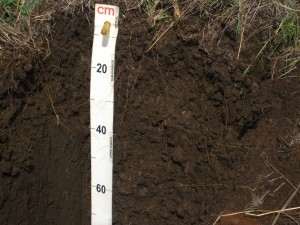Can we increase stable soil carbon levels with no till cropping systems?
and
Will crash grazing plant matter to the soil surface increase stable soil carbon levels?
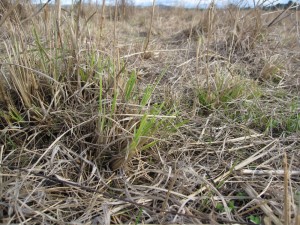
These are important things to consider, as carbon is one of THE main things that will help to restore our soils. It will increase the resilience of our farm businesses in dry times, by allowing greater water holding capacity of our soils. And longer dry spells we are having – with more intermittent rainfall events. For most of us, water is the most limiting factor in our production systems.
Before I answer the questions posed above, it will help to look at the process of how stable soil carbon is created.
SOIL MICROBIOLOGY & CARBON
One method of regenerating soil health under natural systems relies on encouraging carbon cycling and the action of microbiology in the soil. These interact with, and can in turn, influence soil nutrients, soil structure and soil water holding capacity.
How does Carbon get in the soil?
Jones, C. (2009) explains well how carbon gets from the air to our soil via a 4 step process.
1 Photosynthesis
Energy (ie. sunlight) is captured and stored by the plant.
Green plants (in the chloroplasts) convert carbon dioxide (from the air) and water (from the soil) into simple sugars or glucose using sunlight energy – this is photosynthesis. Oxygen is released to the atmosphere in the process.
2 Resynthesis
The glucose (containing carbon) is remade into other compounds.
“Through a myriad of chemical reactions, the glucose formed during photosynthesis is resynthesised to a wide variety of carbon compounds, including carbohydrates (such as cellulose and starch), proteins, organic acids, waxes and oils. …… The energy captured during photosynthesis and stored in carbon compounds serves as ‘fuel’ for life on earth.”1
3 Exudation
The carbon compounds ‘fuel’ the soil.
“Around 30-40% of the carbon fixed by grass plants during photosynthesis can be exuded into soil to form a microbial bridge – that is – to nurture the microbes that enhance the availability of essential plant nutrients. In this way, actively growing crops and pastures provide ‘fuel’ for the soil engine.
Carbon compounds and the microbial populations they support are essential to the creation of topsoil from the structureless, lifeless mineral soil produced by the weathering of rocks.
However, exudation does not occur to any significant extent if high rates of water-soluble nutrients such as phosphorus and/or nitrogen have been applied. These high analysis fertilisers disrupt the sensitive biochemical signalling mechanisms between plants and soil microbes.
Provided the microbial bridge is intact, organic carbon additions are governed by the volume of plant roots per unit of soil and their rate of growth. The more active green leaves there are, the more healthy roots there are, the more carbon is exuded. The breakdown of fibrous roots pruned into soil through rest-rotation grazing can also be an important source of carbon in soils.”2
4 Humification
Keeping the carbon in the soil.
Stable Carbon
Once we’ve got the carbon in the soil it must be retained there, long term, to be of any use to our cropping and grazing systems. To ensure this, it must be present in a stable or non-labile form.
Humic substances are the biggest source of the stable form of carbon in the soil. It is predominantly formed in soils with high microbe levels. The plants release soluble carbon from their roots as exudates, which are resynthesized by soil microbes (particularly symbiotic fungi like mycorrhizae) into stable forms of carbon.
So, any farming practices that enhance and protect the soil biota will help to increase carbon sequestration into the soil and in a stable (and long term helpful) form. These might include reconsidering fertiliser choice, the reconsideration of pesticide and/or herbicide choice or use, the avoidance of soil tilling, the choice of perennial pastures over annual fodder crops for livestock and the limitation of fallow periods in cropping, during which soil biota is not supported by root systems.
It should also be noted that in exchange for the carbon, the mycorrhizae and soil bacteria provide zinc, phosphorus and nitrogen to the plant. The hyphae can link the root systems of different plants, transporting nutrients from one to another. Mycorrhizal fungi, which are totally dependent on liquid carbon from green plants, trade this carbon with colonies of bacteria located at their hyphal tips in exchange for macro-nutrients such as phosphorus, organic nitrogen and calcium, trace elements such as zinc, boron and copper, and plant growth stimulating substances (Killham 1994)3. While I am concentrating on carbon here, we can also see the interaction between the plant (with its carbon exudates), nutrient availability and soil fertility.
Once in the form of humus, the carbon can remain in the soil for decades, centuries or even longer.
Non stable carbon
Non stable or labile carbon, which is more easily broken down or displaced from the soil, forms in a different manner. It “arises principally from biomass inputs (such as crop residues) which are readily decomposed” and return to the atmosphere as carbon dioxide. Proof of this lies in the analysis of the types of microbiology in the soils.
“The types of fungi that survive in conventionally managed agricultural soils are mostly decomposers, that is, they obtain energy from decaying organic matter such as crop stubbles, dead leaves or dead roots. As a general rule these kinds of fungi have relatively small hyphal networks. They are important for soil fertility and soil structure, but play only a minor role in carbon storage.”3
If what Jones explains is correct, then we begin to realise that many of our farming practices may encourage carbon into the labile pool, but not the non-labile or stable pool. No till farming (and stubble retention) and the trampling of organic matter onto pasture surfaces may not lead to significant increases in STABLE carbon in the soil and its associated benefits. The decomposing organic matter will more likely enter the labile carbon pool before re-entering the atmosphere at a later date to again be carbon dioxide from whence it originally came via photosynthesis. We must therefore encourage as many actively growing roots, for as much as the year as possible in order to best increase stable soil carbon levels. This is exactly the beauty of pasture cropping – as explained in last week’s blog.
Humic substances not carbon
So, when we talk about putting carbon in our soils, perhaps we should shift our focus to be on building humic substances in the soil (ie. the type of carbon). This is a subtle shift in our focus, but with potentially very different outcomes. (It’s the old ‘what we focus on is what we get). As well as storing carbon, humic acids help with “ph buffering, inactivation of pesticides and other pollutants, improved plant nutrition and increased soil-water-holding capacity. By chelating salts, humic substances can also effectively ameliorate the symptoms of dryland salinity. Increasing the natural rate of humification in the soil therefore has highly significant benefits for the health and productivity of agricultural land.”5
It should be noted that plant material and organic matter at the soils surface does have lots of benefits, like keeping soils cool in summer, preventing moisture loss from soils, for nutrient turnover and for erosion prevention, among other things – many of which will indirectly help with the survival of soil biology. It just may not directly impact on long term stable increases in carbon, given what Jones reports.
Please don’t think for a minute that I am taking away from the many great advantages that no-till systems and crash grazing have provided to us. It is important however, that we understand what and how these practices are contributing to our farms. Much of the crash grazing principles are about the shearing off of root systems, which then stimulates active root growth, which WILL help to contribute to stable soil carbon levels. It is important however, to understand and differentiate what active root growth and what trampled plant matter at the surface (or stubble in the case of cropping) are contributing, in order to maximise the output and productivity and to achieve the regenerative effects of these systems.
Personal Experiences
I’d like to share with you my past experience of planned grazing our own beef cattle farm near Caroona in NSW (Australia). Each new management system comes with challenges and learnings and this was ours. We run a planned grazing system, with sub-tropical pastures providing explosive growth in summer following big rain events. (It is not uncommon in recent years to have several dry months followed by 3 or 4 inches/75-100mm of rain). Such explosive growth left us with a huge quantity of pasture feed (and essentially understocked). The result of this was that once grazed, a paddock or pasture was not re-grazed for a long period, as we were utilising other paddocks. This happened several times over, and during the periods in between grazings, our pastures got to physiological maturity (and essentially were not growing). This meant that there were long periods when there was not active root growth.
We had fantastic ground cover of trampled plant material, which was great, but we were likely not sequestering much stable carbon. We now still concentrate on ensuring that plants are adequately recovered before re-grazing, but we also concentrate on coming back in soon enough that we keep the plants actively growing as much as we can during the growing season. To do this it can mean dropping a few paddocks out of our planned rotation. Although I can’t comment on the carbon levels during that period, (as we don’t have coinciding soil tests), I believe the soil health did suffer. This was evident in the look of the pastures (not necessarily a reflection of carbon, but of general nutrition).
Some quick particularly intensive grazes, with stock returning to the paddock immediately upon recovery is a good way to kick start the soil system again.
I will also note here that some years after changing to planned rotational grazing, we ripped a pipeline through one of our red soil paddocks. It was quite amazing to see the top foot or so of soil a much richer, darker colour to the top, which we knew represented good improvements.
You can see remnants of the old soil colour in this photo – there are a few light red aggregates remaining. The whole profile used to be this colour.
It was not until sometime later that I learnt the colour change in soil is a result of microbiology activity (Wheeler, I. personal communication, Mar 2013), not necessarily a reflection of carbon levels. One may well expect however, that with soil microbiology at a level that is having such an effect on soil colour, that there is likely some resulting carbon increases).
Measuring
It is also pertinent to consider how we measure carbon. We already have the capacity to measure the labile and non-labile portions in the soil. What should be considered is the depth to which we measure carbon. The Australian National CSIRO Soil Carbon Research Programme (SCaRP), a nationally coordinated program of soil carbon research, linked to the carbon farming initiative (CFI) measured carbon levels to 30cm. I am not alone in suggesting that (if root exudates are a key contributor to soil carbon) we should be measuring carbon to the plant’s rooting depth to get a true feel for carbon levels – especially given Australian Government plans for tracking and rewarding growers that have achieved increases, through the Carbon Farming Initiative.
I know some growers already choose to test to a greater depth.
The following images clearly shows pasture roots to depths of 100cm, and more dense roots at depth of 60cm. These images were taken from recent soil pits dug on our farm. So, this means we can place carbon at these depths.
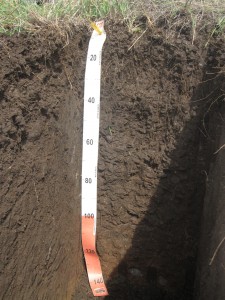
But, can all different sorts of soil support the much needed microbiology so that farmers all over can reap the benefits of storing stable soil carbon? Remember the sand soils of WA from last week?
The answer is yes. Moisture is one of the most highly influential things on the activity of soil microbiology. So, naturally dryer soils have less ability for active soil life than a more moist soil. But these sandy soils CAN support soil biology that will aid in soil improvements.
What are the other ways that we can increase soil carbon?
There are other ways to increase soil carbon levels, such as composts & manures, as well as biochar. Are these as effective or as efficient as through the liquid carbon pathway? I may consider these in another blog.
What are your personal experiences with building stable soil carbon?
References
1 & 2. Jones, C. 2009. Submission to the Environment and Natural Resources Committee. Inquiry into Soil Sequestration in Victoria. APPENDIX D: How does atmospheric carbon get into soil? Available from: <http://www.parliament.vic.gov.au/images/stories/committees/enrc/soil_carbon_sequestration/submission/Australian_Soil_Carbon_Accreditation_Scheme_ASCAS.pdf>. [6th May, 2014].
3 & 5. Jones, C. 2008. Liquid Carbon Pathway Unrecognised. Available from http://www.amazingcarbon.com/PDF/JONES-LiquidCarbonPathway(AFJ-July08).pdf [21st May 2014].
4. Leake, JR 2004. Networks of power and influence: the role of mycorrhizal mycelium in controlling plant communities and agroecosystem functioning. As seen in Jones, C. 2008. Liquid Carbon Pathway Unrecognised.

